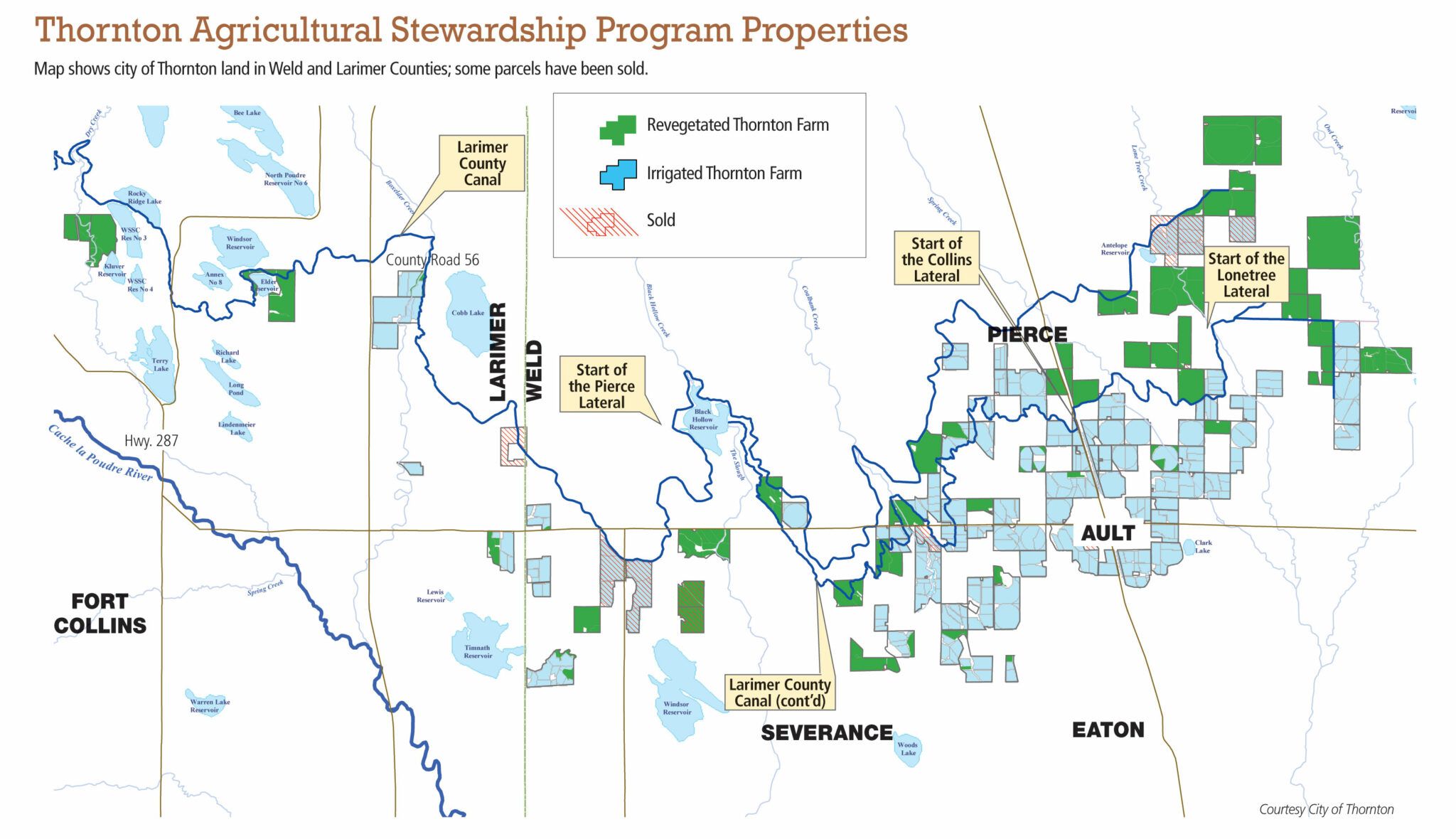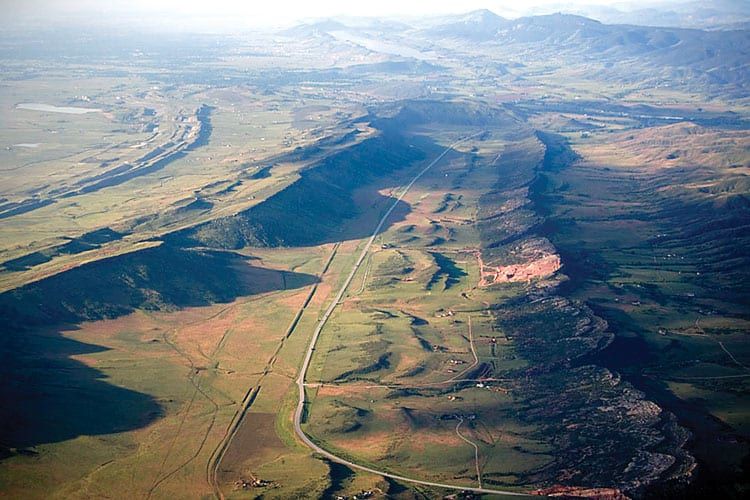Thornton land planning includes community, continuing ownership

THORNTON — The city of Thornton has said it doesn’t want to own land forever in Weld and Larimer counties.
But it’s going to be a few more years, at least.
“We have no near-term plans to sell,” said Emily Hunt, deputy director of infrastructure for Thornton. “But eventually … ”

The trailing off into silence speaks to the complexities of divesting an original 20,500 acres the city accumulated in the mid-1980s. About 1,800 acres have been sold or swapped over the past 30 years, according to Hunt. She helps guide Thornton in this awkward role as both intentional and unwilling landlord over the 18,700 acres the city continues to hold but, in a confluence largely to be wished, that it eventually will not.
SPONSORED CONTENT
Buying Land
Thornton bought the parcels in 1986 and 1987 as a separate water project it was planning to be part of began to crumble, Hunt said. Denver Water in the 1970s had begun working on a proposed dam and reservoir layout called Two Forks, southwest of the city. Thornton had been an original participant.
Cities in Denver’s orbit were beginning to boom and “a whole bunch of partners” signed on to “a massive project to supply water for the entire metro region, to help Denver and its growing suburbs,” Hunt said.
The early 1980s also saw an environmental movement gathering steam that opposed Two Forks. In March 1990, the Environmental Protection Agency nixed the project. Thornton saw it coming and had begun buying land, and water for its future supply.
“Thornton very wisely saw this project wasn’t going to happen and realized it had to find another way.”
This was well before Hunt’s city tenure — “I was in the fifth grade” — and well before everyone saw the city in two years buy up irrigated agricultural land totaling nearly twice the size of Manhattan.
Courting Water
This is the answer to the question, Why didn’t everyone do that?
“When EPA vetoed the project [Two Forks], this really started the scramble,” Hunt said. Thornton was “ahead of the curve because we bailed on Two Forks before it died.”
Because buying water rights 75 miles north of the city was unthinkable, nobody considered hiring a local broker to buy farms and their water rights. Except Thornton did think of it.
“There was a lot of animosity up north” when the money behind the buying was revealed, Hunt said.
The city ended up buying 118 farms combining for the 20,500 acres. It has sold or swapped, in one case for land in Thornton, a half-dozen farms with about 1,800 acres. Some 11,000 of the 18,700 that remain are still in agricultural use by 112 farms, tenants of Thornton. The rest “are in our revegetation program and have been converted to self-sustaining grasses.”
The investment was $51 million and its current value, largely due to the water rights Thornton sought, is much higher. On inflation alone, the 1986-1987 dollars would be about $126 million today.
According to the U.S. Department of Agriculture, dryland in Colorado is currently selling for about $1,370 an acre and irrigated acres average $5,300 per acre, which means the land without the water is worth about half what Thornton paid, absent development demand.
Water rights make the deal. These are about 20 times higher now. Rights that sold for $75,000 a share in the mid-1980s are, on the low-end, valued at about $1.5 million a share today.
Thornton Water Project Director Mark Koleber said most of Thornton’s water rights are via its shares in Water Supply and Storage Co. — it owns just less than half of WSSC — with the rest in Jackson Ditch Co., both in Fort Collins.
These are essentially paper profits, of course, since what Thornton was after was water.
Moving Water
Koleber said the city intends to build a pipeline that eventually will bring an average of 14,000-acre feet of water to the city per year. But that’s with “full development of the pipeline and more development in Thornton.”
The overall timeline is measured in decades, or roughly by 2065.
Of 74 miles of proposed pipeline, 50 miles runs through unincorporated areas of three counties: Weld, Larimer and Adams. Weld has 34 of the 50 miles, Larimer 11 and Adams five, Koleber said.
Thornton has battled Weld and Larimer and the latter dispute is still in the courts at the appellate level. A Larimer County District Court in February said the county could deny Thornton’s request for permits for the pipeline.
With cities in both counties pulling water from WSSC, there was public opposition as well, based on the water quality questions, riparian habitats and aesthetics.
Thornton had sued Larimer in March 2019. No appellate action is expected until about mid-2022.
Thornton had also sued Weld County, but the dispute is done for now and the city and county have agreed on proceeding with the pipeline, with Thornton committing to cover costs for road damage from building the pipeline, get permits and coordinate with the county to keep it updated on progress.
With Adams, Thornton “is getting everything pulled together,” Koleber said and the city expects to seek permits this year.
Seven of the remaining 24 miles that run through cities and towns are built — essentially the only parts of the pipeline that are. The seven miles are in the towns of Windsor and Johnstown.
The remaining 17 miles run through land in the growth management area of Mead and include portions of the towns of Timnath, Firestone and Frederick, and the city of Dacono, as well as Thornton itself. Building for these areas could require intergovernmental agreements, permitting and so on.
“A lot of it will be concurrent construction on a number of project segments,” Koleber said. Significant starts on these segments should come in 2022.
Sustaining Land
The 1980s Water Court decree enabling Thornton to eventually get that water into the pipe requires them to care for the land.
“When we pull the water off the land and it’s no longer being used for farming, we have to develop ‘self-sustaining, non-irrigated use,’” Hunt said.
It takes five to seven years to convert watered farmland to self-sustaining without the water, Hunt noted.
“Currently we’re grass and hay farmers” on revegetated acres, Hunt said. This brings in a couple hundred thousand dollars a year. Thornton cuts, bales and sells the hay to local ranchers and is looking into ways it could graze cattle directly so no equipment is needed. Overall haymaking “doesn’t quite pay for itself.”
Hunt said the farm-leasing business is break-even. Rent covers administrative costs. The city also owns about 50 farmhouses on its real estate, she said.
“At the end of the day, a lot of the farmers we purchased from are still our farmers,” she said. “We kind of helped them stay in business” through economic times when their options would have been limited.
Some of the neighboring farms, and communities in general, including cities that didn’t see what wasn’t coming with Two Forks, weren’t as pleased.
“And in my mind,” Hunt said, “that’s completely understandable.”
Stewardship
She said Thornton in the last decade pivoted philosophically, to work with and listen to communities.
The land that got Thornton its water rights is largely in Weld. Within the county, acreage predominates near Pierce and Ault, the latter of which it nearly surrounds.
The feedback was harsh.
Some land it owned “was limiting what communities could do, what they want to do.” Pursuing what it saw best for itself and its citizens was how Thornton got the land in the first place, Hunt said. Maybe a method of helping other cities do the same thing for their residents had to come under consideration. Thornton began to consider ways its real estate experiment might go better until it gets to the end. This led to the Agricultural Stewardship Program, which refers to what the city will do with the land. It’s a sibling effort to its Water Project, which applies to the water side of the work.
Butch White, mayor pro-tem of Ault, concurred that the land purchases were limiting for towns like Ault.
“[It] had an impact on our school district, fire district and economy. I think the biggest impact we have seen as a community is the loss of the small family farm,” White said in response to an email question. “With fewer and fewer farmers farming more land we saw declines in enrollment in the schools and an economic impact on ag related businesses. I think you also saw a loss of pride of ownership and community involvement.”
Thornton hired a consultant, kicked in cash and recently added $500,000 in state and federal grants, and has been working on land use analysis and other elements of investigation.
The work included data collection on soil, how cities are affected and conservation questions.
Now, Hunt said, “we can start working on creative solutions.”
Thornton is convening a steering committee next month that will commit to 18 months of work to identify opportunities for each piece of land.
“It’s going to be done in a thoughtful way, aligned with the communities,” and Thornton’s need for water, and developed by the committee. Results will help inform land management, guide land sales, how best to sell or swap if at all, whether grazing can continue and so on.
“I can’t say what will happen because it needs to be organic” and “respond to the market and to Thornton’s needs.”
White said he’s optimistic about what is to come. “We are happy to be working with the city of Thornton to study and plan the future use of the properties being sold. I don’t think we want to comment on the disposition of the properties at this point as the process is still being looked at. I will tell you I think the city of Thornton is taking it seriously and putting a lot of effort into it.”
Ken Amundson contributed to this report.

THORNTON — The city of Thornton has said it doesn’t want to own land forever in Weld and Larimer counties.
But it’s going to be a few more years, at least.
“We have no near-term plans to sell,” said Emily Hunt, deputy director of infrastructure for Thornton. “But eventually … ”

The trailing off into silence speaks to the complexities of divesting an original 20,500 acres the city accumulated in the mid-1980s. About 1,800 acres have been sold or swapped over the past 30 years, according to Hunt. She helps guide Thornton in this awkward role…
THIS ARTICLE IS FOR SUBSCRIBERS ONLY
Continue reading for less than $3 per week!
Get a month of award-winning local business news, trends and insights
Access award-winning content today!





